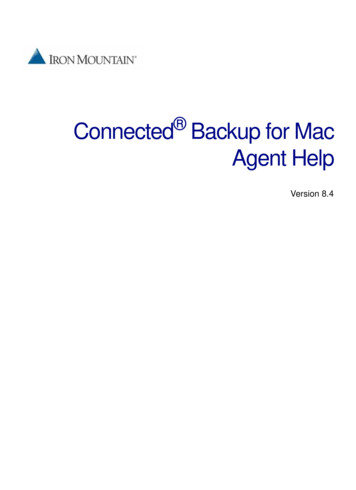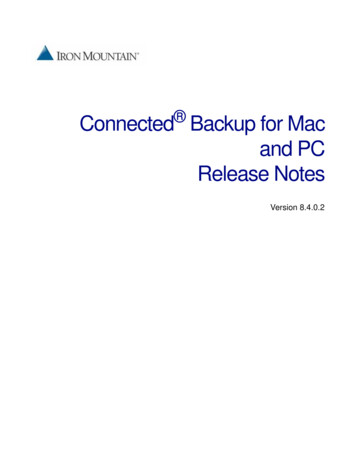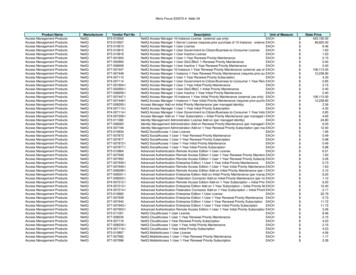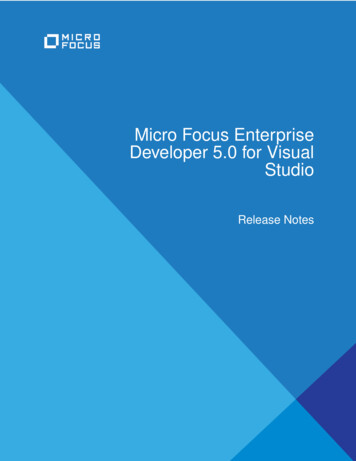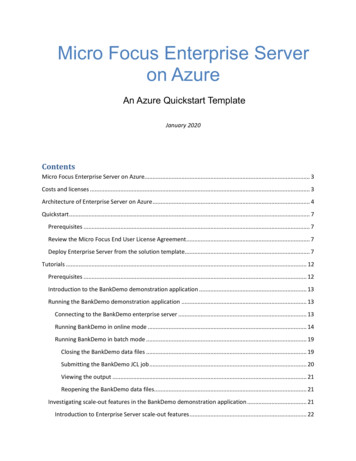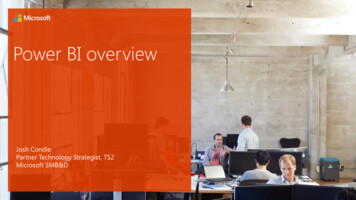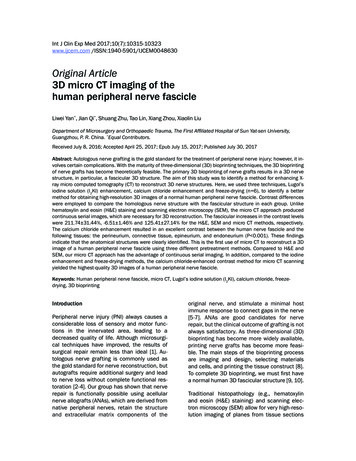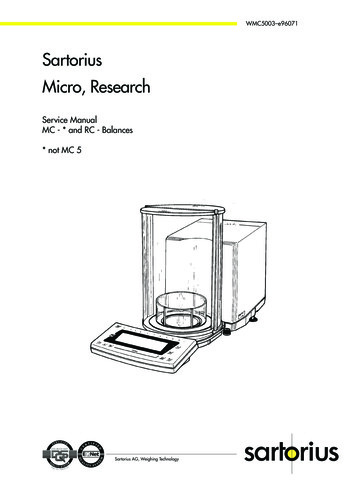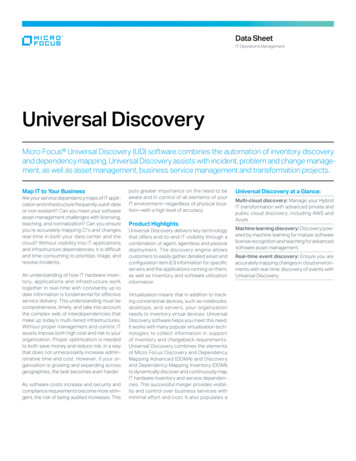
Transcription
Data SheetIT Operations ManagementUniversal DiscoveryMicro Focus Universal Discovery (UD) software combines the automation of inventory discoveryand dependency mapping. Universal Discovery assists with incident, problem and change management, as well as asset management, business service management and transformation projects.Map IT to Your BusinessAre your service dependency maps of IT application and infrastructure frequently outof-dateor non-existent? Can you meet your softwareasset management challenges with licensing,teaching, and normalization? Can you ensureyou’re accurately mapping CI’s and changesreal-time in both your data center and thecloud? Without visibility into IT applicationsand infrastructure dependencies, it is difficultand time-consuming to prioritize, triage, andresolve incidents.An understanding of how IT hardware inventory, applications and infrastructure worktogether in real-time with constantly up todate information is fundamental for effectiveservice delivery. This understanding must becomprehensive, timely, and take into accountthe complex web of interdependencies thatmake up today’s multi-tiered infrastructures.Without proper management and control, ITassets impose both high cost and risk to yourorganization. Proper optimization is neededto both save money and reduce risk, in a waythat does not unnecessarily increase administrative time and cost. However, if your organization is growing and expanding acrossgeographies, the task becomes even harder.As software costs increase and security andcompliance requirements become more stringent, the risk of being audited increases. Thisputs greater importance on the need to beaware and in control of all elements of yourIT environment—regardless of physical location—with a high level of accuracy.Product HighlightsUniversal Discovery delivers key technologythat offers end-to-end IT visibility through acombination of agent, agentless and passivedeployment. The discovery engine allowscustomers to easily gather detailed asset andconfiguration item (CI) information for specificservers and the applications running on them,as well as inventory and software utilizationinformation.Virtualization means that in addition to tracking conventional devices, such as notebooks,desktops, and servers, your organizationneeds to inventory virtual devices. UniversalDiscovery software helps you meet this need.It works with many popular virtualization technologies to collect information in supportof inventory and chargeback requirements.Universal Discovery combines the elementsof Micro Focus Discovery and DependencyMapping Advanced (DDMA) and Discoveryand Dependency Mapping Inventory (DDMI)to dynamically discover and continuously mapIT hardware inventory and service dependencies. This successful merger provides visibility and control over business services withminimal effort and cost. It also populates aUniversal Discovery at a Glance:Multi-cloud discovery: Manage your HybridIT transformation with advanced private andpublic cloud discovery, including AWS andAzure.Machine learning discovery: Discovery powered by machine learning for mature softwarelicense recognition and teaching for advancedsoftware asset management.Real-time event discovery: Ensure you areaccurately mapping changes in cloud environments with real-time discovery of events withUniversal Discovery.
Data SheetUniversal Discoverysingle repository, the Micro Focus UniversalConf iguration Management Database(UCMDB), to create an accurate model ofyour IT environment.Universal Discovery and the Universal CMDBare tightly integrated. UD combined with theUniversal CMDB enables a top-down andbottom-up view of the relationships betweenIT hardware inventory, elements and businessservices. UD generates an automated, continuously updated map showing both IT elementsand relationships, extending to the cloud andpopulates this data into the Universal CMDB.This tight integration with the CMDB streamlines data instantiation, updates, and predictive change impact analysis rather thanrelying on piecing together two or moreseparate solutions.Agent discoveryIntergrated data sourcesConsumersUCMDB serverPassive discovery probeAgent and agent discoveryAgent discoveryFigure 1. Elements to create an accurate model of your IT environmentFigure 1. Elements to create an accurate model of your IT environmentKey FeaturesBreadth and Depth of DiscoveryUniversal Discovery provides the basis forunderstanding the services that IT delivers—from the physical layer of the data center all theway to the business process layer.Unlike network-oriented discovery products or asset inventory products, UniversalDiscovery explores assets and configurationitems (CIs) from layer 2 through layer 7 of theOpen Systems Interconnection (OSI) model,as well as deep-device and application-specific information. Importantly, it also exploresand maps the relationships between theseelements beyond the traditional uses and2contains relationship types. It is object-oriented, allowing specific CIs and relationshipsto be discovered using a library of discoverypatterns that can capture: High-level applications and theircomponents, such as WebSphere,WebLogic, GlassFish, MQ, SAP, and Siebel JCo3, J2EE or .NET components Custom or legacy applications Database components, such astablespaces, users, and jobs Servers and server inventory andresources, such as CPUs, memory,network interfaces, and storage devices Network devices, such as routers,switches, load balancers, switch ports,VLANs, and firewalls Storage elements, including storagearrays, logical disks, and interconnectivitybetween SAN elements, also included isdiscovery of VMware storage topologyincluding VMware data stores, VM filesystems, local storage on the ESX serversand the relations between them Virtual environments for VMware,Microsoft, Oracle VM Server for SPARCand Xen; including virtual file systems,disks, network interfaces, andmanagement servers
PCs, laptops, printers Private and public cloud deploymentsutilizing Amazon Web Services (AWS)EC2 and vCloud Mainframe/iSeries (AS/400) attributessuch as LPARs, sysplexes, TCP, UDP,and start tasks, in addition, IPv6 support,address space discovery, Ciscoconnectivity, and WebSphere discovery The relationships that exist between allof the above elementsThird-party product integrations support thediscovery and dependency mapping of lowerand higher layers of the OSI model as well. Forinstance, UD integration with the EmersonAperture product line helps you understandthe physical layer of the data center such aswhat physical racks servers are deployed onto(OSI layers 0 and 1), detailed information onpower supply to racks and individual servers. This also enables impact analysis from apower supply point of view and makes it possible to analyze impact of power failure onapplications, business services and lines ofbusiness in UCMDB. UD, through the use of apull adapter, can also leverage the BMC AtriumCMDB by pulling assets, CIs and relationshipsfrom BMC Atrium to create the same topologyin UCMDB. In addition, integrations with thirdparty products such as Troux and CiscoWorkscan provide insight into which business processes depend on which IT infrastructure.UD also supports integration with other IT solutions to leverage deep configuration information around specific IT domains. Domains suchas storage, server, or network environmentscan be extended through integration with solutions such as Micro Focus Storage Essentialssoftware, Micro Focus Network Node Managersoftware, and VMware VirtualCenter.Gain Control with Universal DiscoveryUniversal Discovery enables your IT organization to better utilize your hardware andsoftware assets. It helps you identify whichwww.microfocus.comhardware devices need to be upgraded. It assists in enforcing compliance by identifyingall installations of software (authorized andunauthorized) and allows your organization tooptimize software license expenses and avoidpenalties for unauthorized use of software. Iteven identifies what applications are usedmost frequently to help you further optimizeyour software expenditures.functionality to facilitate inventory of users fornon-durable connections and the agent will issue a call to collect all the data as soon as element is reconnected to the network. Lastly, UDincludes a Native Agent Packaging and UNIX agents are packaged into the native OS package format allowing the agents to be installed/uninstalled using the native package manager.A wrapper installation script has also been provided to simplify the process.Spiral MethodologySpiral discovery characterizes the Micro Focusapproach to active discovery. Active discoveryis performed by discovery patterns—essentially pieces of functionality that allow UD togather a specific type of information. Each discovery pattern gathers only a small piece ofthe puzzle. By running multiple patterns, eachbuilding on the next, a rich model of the IT environment is created. This approach is highlyefficient and can be easily tailored to meet theunique requirements of your IT environment.Hybrid DiscoveryIn an effort to simplify administration, UniversalDiscovery uses a single UI and data repositoryto support both agent and agentless discovery and dependency mapping of assets toprovide detailed configuration information. Asingle data flow probes can now be configuredto run an agent discovery, agentless discoveryor a combination of both.Agent-Based DiscoverySecure communications with the discoveryagent provides the ability of discovery probesto enable remote management. Additionally,part of simplifying the deployment and management of credentials, Universal Discoveryprovides a shell protocol which allows agentless discovery patterns to be executed similarto using SSH/NTCMD on end points that haveUD agents installed on them. In other words, ifa user has an agent on the box, with the protocol a user can now run an agentless scanover the top of the existing agent scan. Agentdiscovery also introduces a new Call HomePassive (Real-Time) DiscoveryUniversal Discovery integrates with Real UserMonitoring (RUM), as a passive discoveryprobe, to continuously sense network traffic inreal time allowing for the capture non-durableconnections as well as durable connections.Passive discovery also introduces transaction/application scope discovery. This allowsthe administrator to capture a true picture ofthe actions or traffic associated with their infrastructure. Passive discovery keeps a useraware, at all-times, what is presently happening, while an active discovery only captures ascheduled snapshot.Zone-Based DiscoveryDiscovery management provides the capability to creating defined zone in the UI for aregion of the infrastructure of organization.Customers can define Data Center X as aManagement Zone when they need to eitherdiscover all windows machines of Data CenterX every week and using the same discoveryparameters or discovery all J2EE-Servers ofData Center X every day and using the samediscovery parameters. Each managementzone can have an individual parameter forschedule or discovery category, such as anapplication or mainframes, for an IP ranges. Aretailer might set up each store as a separatemanagement zone for example.Real-Time Discovery in the CloudCloud architectures are changing the industry as they provide end users with the flexibility and agility to self-provision, start, stop,3
Data SheetUniversal Discoverysnapshot, and archive components at the IaaSand PaaS levels. This ability allows changes tonow occur in minutes versus hours or days.The majority of existing discovery technologies in the industry are schedule-based, andthey are unable to keep track of these dynamicchanges made in cloud environments in thistime frame, causing potential for negativeimpact to end users if cloud-based changesand CI’s are not found and tracked effectivelyin real-time.However, UD offers real-time discovery ofcloud architectures based on discovery occurring immediately after an event takes place.This allows public (such as AWS, Azure, andGCP) and private cloud changes to be trackedin real-time, and cloud architectures to alwaysbe up-to-date.Asset ManagementWith out-of-the-box integrations with otherproducts like Asset Manager and ServiceManager within the ITSMA Suite, and UniversalCMDB software—Universal Discovery provides a central source of hardware andsoftware inventory data, to help reduce thecomplexity of IT environments and help optimize the investment in management software.The device discovery capability of UD automates the discovery, classification, anddocumentation of every network-connecteddevice, including workstations, laptops, mobile devices, servers, routers, hubs, switches,printers, IP phones, and firewalls. In-depth inventory and usage information is collected viaagents from a large range of platforms, including AIX, HP-UX, Solaris, Linux, and Windows.Accurate software recognition is also thebasis for reconciling installed applications tolicensable entitlements for both stand-aloneand suite-based license grants.With Smart Software Analytics in UD, the industry-leading IDOL platform for unstructured4data search has been added to UniversalDiscovery. This adds a level of machine learning to software license discovery, providingvastly improved software application index(SAI) maturity within an organization throughautomated software recognition and teaching.UD provides an accurate picture of your ITenvironment through reliable discovery andinventory techniques. It helps you solve keychallenges around cost reduction, security,and compliance.Automated Service ModelingUD provides the ability to automatically discover and model critical business servicesand business applications, starting from anentry point for the service (for example theURL of the service) and create a model of aparticular service or and enterprise applicationby automatically leveraging the existing
Universal Discovery Micro Focus Universal Discovery (UD) software combines the automation of inventory discovery and dependency mapping. Universal Discovery assists with incident, problem and change manage - ment, as well as asset management, business service management and transformation projects. Map IT to Your Business
